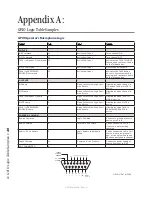
C
: A
ES
67 •
5
0
© 2016 Axia Audio - Rev 2.0
Appendix C:
AES67
AES67 standard defines an interoperability mode for transport of high performance audio over networks based on
the Internet Protocol. For the purposes of the standard, high performance audio refers to audio with full bandwidth
and low noise . These requirements imply linear PCM coding with a sampling frequency of 44,1 kHz and higher and
resolution of 16 bits and higher. High performance also implies a low latency capability compatible with live sound
applications. The standard considers latency performance of 10 milliseconds or less.
xNodes implementation is compliant with the standard supporting interoperability with third party devices. In
particular, the following features are implemented:
• Multicast and unicast Real Time Protocol (RTP) audio streaming
• Session Initiation Protocol (SIP) based connection management for unicast streams
• Transmission of 1ms audio frames in linear PCM 24 bit format
• Ability to receive audio streams containing 1 through 8 channels
• Ability to receive 16 bit as well as 24 bit format
• Support of IEEE1588 2001 Precision Time Protocol standard
• Timestamping outgoing stream with IEEE1588 derived RTP timestamps
Network synchronization setup
AES67 standard requires device to use IEEE1588 network time protocol standard. The Synchronization and QoS
page of the xNode provides the controls to establish the xNode as a system PTP master or slave to a grand master.
Clock mode options allow selecting the operation suitable to the system in which the xNode is being deployed.
• PTP/IEEE 1588 ARB clock class 248 mode allows the node to be a master when no better clock is available
on the network. Since xNodes are not locked to GPS or any other high precision source, only Arbitrary (ARB)
Clock class is provided.
• PTP/IEEE 1588 slave only is recommended for networks with high precision grand masters present.
• Additional options are same as above with Livewire master conditions to allow the xNode to act as a gateway for
synchronization to Livewire legacy products.
PTP domain number should be selected to 0 unless there is a need for multiple clock domains on a network segment.
PTP delay mechanism specifies how the node determines network round trip latency. This setting MUST match the
master clock setting. In practice, End to End (E2E) is always used by ordinary clocks and boundary clocks. Peer to-
Peer (P2P) mechanism was defined to limit amount of traffic reaching the master clock, but is rarely used.
PTP clock priority1/priority2 numbers provide a control over master clock selection. Lower priority number makes the
clock a preferred choice over devices with a higher number. The range is 0 255, and 128 is the default and middle value.







































